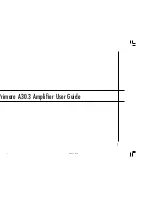
36
User’s Guide OctaMic XTC
© RME
14.3 Cabling and Termination
Word clock signals are usually distributed in the form of a network, split with BNC T-adapters
and terminated with resistors. We recommend using off-the-shelf BNC cables to connect all
devices, as this type of cable is used for most computer networks. Actually you will find all the
necessary components (T-adapters, terminators, cables) in most electronics and computer
stores. The latter usually carries 50 Ohm components. The 75 Ohm components used for word
clock are part of video technology (RG59).
Ideally, the word clock signal is a 5 Volt square wave with the frequency of the sample rate, of
which the harmonics go up to far above 500 kHz. To avoid voltage loss and reflections, both the
cable itself and the terminating resistor at the end of the chain should have an impedance of 75
Ohm. If the voltage is too low, synchronization will fail. High frequency reflection effects can
cause both jitter and sync failure.
Unfortunately there are still many devices on the market, even newer digital mixing consoles,
which are supplied with a word clock output that can only be called unsatisfactory. If the output
breaks down to 3 Volts when terminating with 75 Ohms, you have to take into account that a
device, of which the input only works from 2.8 Volts and above, does not function correctly al-
ready after 3 meter cable length. So it is not astonishing that because of the higher voltage,
word clock networks are in some cases more stable and reliable if cables are not terminated at
all.
Ideally all outputs of word clock delivering devices are designed as low impedance types, but all
word clock inputs as high impedance types, in order to not weaken the signal on the chain. But
there are also negative examples, when the 75 Ohms are built into the device and cannot be
switched off. In this case the network load is often 2 x 75 Ohms, and the user is forced to buy a
special word clock distributor. Note that such a device is generally recommended for larger
studios.
The OctaMic XTC's word clock input can be high-impedance or terminated internally, ensuring
maximum flexibility. If termination is necessary (e.g. because the OctaMic XTC is the last device
in the chain), activate the option
WCK Term.
in the menu
Clock
.
In case the OctaMic XTC resides within a chain of devices receiving word clock, plug a T-
adapter into its BNC input jack, and the cable supplying the word clock signal to one end of the
adapter. Connect the free end to the next device in the chain via a further BNC cable. The last
device in the chain should be terminated using another T-adapter and a 75 Ohm resistor (avail-
able as short BNC plug). Of course devices with internal termination do not need T-adaptor and
terminator plug.
Due to the outstanding SteadyClock technology of the OctaMic XTC, we recommend to not
pass the input signal via T-adapter, but to use the OctaMic XTC's word clock output instead.
Thanks to SteadyClock, the input signal will both be freed from jitter and - in case of loss or
drop out – be held at the last valid frequency.
15. MIDI
The OctaMic XTC has a standard MIDI input and output, a 5-pin DIN jack each. The MIDI I/O is
used for:
•
remote control of the OctaMic XTC, see chapter 11.1
•
transmission of MIDI data and remote control commands over MADI and USB.
Summary of Contents for OctaMic XTC
Page 5: ...User s Guide OctaMic XTC RME 5 User s Guide OctaMic XTC General ...
Page 12: ...12 User s Guide OctaMic XTC RME ...
Page 13: ...User s Guide OctaMic XTC RME 13 User s Guide OctaMic XTC Usage and Operation ...
Page 27: ...User s Guide OctaMic XTC RME 27 User s Guide OctaMic XTC Inputs and Outputs ...
Page 33: ...User s Guide OctaMic XTC RME 33 ...
Page 37: ...User s Guide OctaMic XTC RME 37 User s Guide OctaMic XTC Class Compliant Mode ...
Page 42: ...42 User s Guide OctaMic XTC RME ...
Page 43: ...User s Guide OctaMic XTC RME 43 User s Guide OctaMic XTC Technical Reference ...
Page 58: ...58 User s Guide OctaMic XTC RME 23 Block Diagram ...
















































